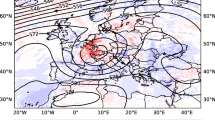Abstract
Droughts and floods are two opposite but related hydrological events. They both lie at the extremes of rainfall intensity when the period of that intensity is measured over long intervals. This paper presents a new concept based on stochastic calculus to assess the risk of both droughts and floods. An extended definition of rainfall intensity is applied to point rainfall to simultaneously deal with high intensity storms and dry spells. The mean-reverting Ornstein–Uhlenbeck process, which is a stochastic differential equation model, simulates the behavior of point rainfall evolving not over time, but instead with cumulative rainfall depth. Coefficients of the polynomial functions that approximate the model parameters are identified from observed raingauge data using the least squares method. The probability that neither drought nor flood occurs until the cumulative rainfall depth reaches a given value requires solving a Dirichlet problem for the backward Kolmogorov equation associated with the stochastic differential equation. A numerical model is developed to compute that probability, using the finite element method with an effective upwind discretization scheme. Applicability of the model is demonstrated at three raingauge sites located in Ghana, where rainfed subsistence farming is the dominant practice in a variety of tropical climates.












Similar content being viewed by others
References
Amani A, Lebel T (1998) Relationship between point rainfall, average sampled rainfall and ground truth at the event scale in Sahel. Stoch Hydrol Hydraul 12:141–154
Bodo BA, Thompson ME, Unny TE (1987) A review on stochastic differential equations for applications in hydrology. Stoch Hydrol Hydraul 1:81–100
Chiang R, Liu P, Okunev J (1995) Modelling mean reversion of asset prices toward their fundamental value. J Banking Financ 19:1327–1340
Chu PC (2007) First passage time analysis on climate indices. J Atmos Ocean Technol 25:258–270
Cowden JR, Watkins DW Jr, Mihelcic JR (2008) Stochastic rainfall modeling in West Africa: parsimonious approaches for domestic rainwater harvesting assessment. J Hydrol 361:64–77
Elliot WJ (1995) Precipitation, chap 2 in Environmental hydrology, pp 19–50. CRC Press, Inc., FL
Evans LT, Keef SP, Okunev J (1994) Modelling real interest rates. J Banking Financ 18:153–165
Gyasi-Agyei Y (1999) Identification of regional parameters of a stochastic model for rainfall disaggregation. J Hydrol 223:148–163
Gyasi-Agyei Y (2001) Modelling diurnal cycles in point rainfall properties. Hydrol Process 15:595–608
Gyasi-Agyei Y (2005) Stochastic disaggregation of daily rainfall into one-hour time scale. J Hydrol 309:178–190
Gyasi-Agyei Y, Parvez Bin Mahbub SM (2007) A stochastic model for daily rainfall disaggregation into fine time scale. J Hydrol 347:358–370
Gyasi-Agyei Y, Willgoose GR (1999) Generalisation of a hybrid model for point rainfall. J Hydrol 223:148–163
Huang MX, Tao XH, Han ZX (2003) An electricity price model with consideration to load and gas price effects. J Zhejiang Univ Sci 4(6):666–671
Jenkins GS, Adamou G, Fongang S (2002) The challenges of modeling climate variability and change in West Africa. Clim Change 52(3):263–286
Koutsoyiannis D, Mamassis N (2001) On the representation of hyetograph characteristics by stochastic rainfall models. J Hydrol 251:65–87
Lawson GW, Armstrong-Mensah KO, Hall JB (1970) A catena in tropical moist semi-deciduous forest near Kade, Ghana. J Ecol 58(2):371–398
Lebel T, Delclaux F, Le Barbé L, Polcher J (2000) From GCM scales to hydrological scales: rainfall variability in West Africa. Stoch Environ Res Risk Assess 14:275–295
Mishra AK, Singh VP, Desai VR (2009) Drought characterization: a stochastic approach. Stoch Environ Res Risk Assess 23:41–55
Najem W (1988) A continuous point process model for daily rainfall. Stoch Hydrol Hydraul 2:189–200
Øksendal B (2005) Stochastic differential equations, 6th edn, pp 179–190. Springer, Berlin
Onof C, Chandler RE, Kakou A, Northrop P, Wheater HS, Isham V (2000) Rainfall modeling using Poisson-cluster processes: a review of developments. Stoch Environ Res Risk Assess 14:384–441
Owusu K, Waylen P (2009) Trends in spatio-temporal variability in annual rainfall in Ghana (1951–2000). Weather 64(5):115–120
Patie P, Winter C (2008) First exit time for multidimensional diffusions: a PDE-based approach. J Comput Appl Math 222:42–53
Spencer BF, Bergman LA (1993) On the numerical solution of the Fokker-Planck equation for nonlinear stochastic systems. Nonlinear Dyn 4:357–372
Unami K, Kawachi T, Kranjac-Berisavljevic G, Abagale FK, Maeda S, Takeuchi J (2009) Case study: hydraulic modeling of runoff processes in Ghanaian inland valleys. J Hydraul Eng ASCE 135(7):539–553
Wu SJ, Yang JC, Tung YK (2006) Identification and stochastic generation of representative rainfall temporal patters in Hong Kong territory. Stoch Environ Res Risk Assess 20:171–183
Acknowledgements
This research was supported by a grant-in-aid for scientific research No.20255012, from the Japan Society for the Promotion of Science.
Author information
Authors and Affiliations
Corresponding author
Rights and permissions
About this article
Cite this article
Unami, K., Abagale, F.K., Yangyuoru, M. et al. A stochastic differential equation model for assessing drought and flood risks. Stoch Environ Res Risk Assess 24, 725–733 (2010). https://doi.org/10.1007/s00477-009-0359-2
Published:
Issue Date:
DOI: https://doi.org/10.1007/s00477-009-0359-2




